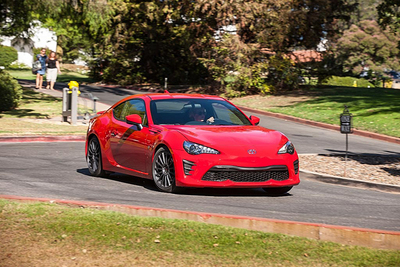First Drive Review: 2017 Toyota 86 by Henny Hemmes +VIDEO
By Henny Hemmes
Senior European Editor
• SEE ALSO: Toyota Research and Buyers Guide
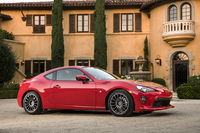 2017 Toyota 86 |
OJAI, CA - October 4, 2016: Last week I had the opportunity to drive the new Toyota 86. The sports coupe that's now badged "86" was originally introduced a few years ago as GT86, has been updated with a stronger design and a refreshed cabin. The suspension has been tuned for greater agility and the stick-shift model has more performance.
The 2017 Toyota 86 also marks the transition of the Scion FR-S, the first born triplet brother of the Toyota GT 86 and Subaru BRZ, to the Toyota brand. When Toyota introduced Scion in 2003, I would not have forecasted that the youth brand would remain as young as just 13 years. Scion officially went out of business this past summer, but the FR-S and some other Scion models will live on as a Toyotas.
Standard LED
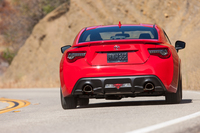 2017 Toyota 86 |
The 2017 model stands on new twisted spoke 17-inch alloy wheels and graphic 86 logos have been incorporated into a badge on the front fender, as well as inside the front headlamps.
Stick-shift model gets an extra 5 hp
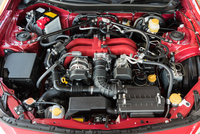 2017 Toyota 86 |
One of the features of the engine is Toyota’s D4-S fuel injection system that combines direct injection and port injection technologies. The direct injection provides a cooling effect in the cylinders, allowing the engine to use a high 12.5:1 compression ratio. The port fuel injectors are operating during light- and medium-load conditions to maximize combustion efficiency for sporty performance, without sipping too much gas. The EPA fuel consumption is estimated at 24/32 mpg for the six-speed automatic and at 21/28 for the six-speed manual.
On the road
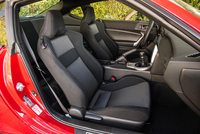 2017 Toyota 86 |
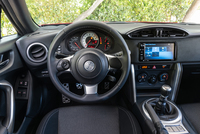 2017 Toyota 86 |
The steering wheel is new, has audio controls and a 86-logo, and is the smallest one ever fitted in a Toyota. New is also the 7-inch touch screen display with integrated rear view function.
When I drove a prototype in California in 2014, I was already impressed by its sharp handling. The 2017 model gets 50 per cent stronger strut towers and the C-pillar is strengthened by an extra 4 spot welds (over 10 in the outgoing model). These measures improve damper and spring rigidity. Front and aft the shock absorbers have a somewhat softer set-up and at the rear Toyota now uses 1 mm thinner anti-roll bar and reduced the spring rate by 15 per cent for a softer character. Another new feature is the Track mode of stability control to replace the previous Sport mode, and it can be activated with a button in the center part just south of the gear shifter. That way interference of the ESP is limited to a safety ‘back up.’ The standard Torsen limited-slip differential helps maximize traction between the rear wheels while cornering.
With its low center of gravity and a weight of only 2,774 lbs, the car offers excellent handling. The extra horses are hardly noticeable, but the 86 remains sharp towards its red-line of 7,800 rpm. The electric power assisted steering gives good feedback, and is smooth and direct. The front end bites into corners enthusiastically, helped by the softer set up of the rear.
The stick shift is an example of well-known Toyota qualities: crisp and fast shifting with short throws.
Wrapping up, I really liked the well-balanced handling of the compact rear-wheel drive sports car and given the fact that you have to deal with speed limits everywhere, the engine performance may not be super high, it is enough to offer a nice driving experience for an affordable price: $26,255 (plus $ 865 handling). The Toyota 86 goes on sale next month.
The 2017 Toyota 86 comes standard with the STAR Safety System with ABS, Electronic Brake Distribution (EBD), Traction Control (TRAC), Brake Assist (BA), Vehicle Stability Control (VSC) and Smart Stop Technology (SST), as well as 4 airbags in the front, plus front and rear passenger side curtains.



